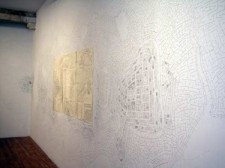
Kim Jones
American, 1944-
Untitled (War Drawing Triptych), 2000, 2001, 2008
graphite on paper
24 x 36 in. (each sheet)
SBMA, Museum Purchase
2013.1

Undated photo, ArtForum
"I work with multiple sketchbooks simultaneously. Whether I am trying to generate ideas or need to work through a concept, I draw a lot to refine, explore, engineer and give visual structure." - Kim Jones

COMMENTS
Kim Jones’ dimensional transgressions are, it would seem, more immediately obvious and tangible than projected scale. For his current solo exhibition at Pierogi, he has again presented one of his work-in-progress war drawings/installations. Entitled “escape from flatland,” the piece contains at its center one of Jones’ untitled drawings depicting the artist’s imaginary war of the dots and x’s. The drawing, “Untitled War Drawing (triptych),” (1993-2003), 38 x 75 inches, was finished when the artist affixed it to the wall, but the rest of the drawing, the part extending out from the paper’s edges, across the walls, around the corners, and over the ceiling, is in constant transformation throughout the length of the exhibition.
Jones was given off-hours access to the gallery, and came in regularly to add to the drawing. Near the end of the show, the artist stages a huge battle, one in which a line of predefined length represents cannon fire, and explosions are manifest as, literally, erasures. Joe Amrhein, Pierogi’s director, hasn’t decided yet if he’s going to paint over the wall part of the drawing when it’s over or, more provocatively, seal the drawing under a thin layer of sheetrock.
Clearly Jones work resists easy classification when we think of scale, even if most archivists in this case understandably opt for “dimensions variable” in the measurement line. And into this mix one must add yet another piece of history: Jones was what was called a “Tunnel Rat” in Viet Nam, meaning that he went underground into long, dark, narrow, booby-trapped tunnels searching for Viet Cong. While the nature of the war drawings would naturally assume an overhead orientation on the part of the viewer, if one were to take a more literal view and see the drawings from the side as they are truly presented how easily they might remind one of those clear plastic ant farms or…those Viet Cong tunnels.
Which raises a more interesting question concerning Jones, for it is not “where is the edge of his work?” but rather “what time frame contains these works?” The date on the untitled drawing covers 10 years, a fairly unusual length of time to engage a single drawing. The artist’s drawings in the second gallery are even more striking in this regard. Having been originally started in 1975, just a few years after Jones returned from duty in Vietnam, they were all recently reworked.
- Deven Golden, Mia Westerlund Roosen and Kim Jones, ArtCritical, March 1, 2004
http://www.artcritical.com/2004/03/01/mia-westerlund-roosen-and-kim-jones/
SBMA CURATORIAL LABELS
Kim Jones, also known as “Mudman,” emerged out of the Southern California performance art scene of the 1970s, where he could be seen walking the streets of Los Angeles and Venice, California, covered in mud with a lattice-work structure of sticks and twine strapped to his back. Much of Jones’s work has been influenced by his father’s and grandfather’s military service, and his own tenure as a United States Marine during the Vietnam War. This is readily visible in "Untitled (War Drawing Triptych)," which depicts intricate map-like battle plans from his imagined war of the dots and the Xs. In 2004, a similar “war drawing” was displayed as the center of a sustained performance piece, wherein Jones expanded his battle scenes beyond the edges of the paper and onto the gallery walls. His work, much like war itself, challenges the boundaries of time and space through the constant addition and erasure of materials over time.
- Left Coast: Recent Acquisitions of Contemporary Art, 2014
